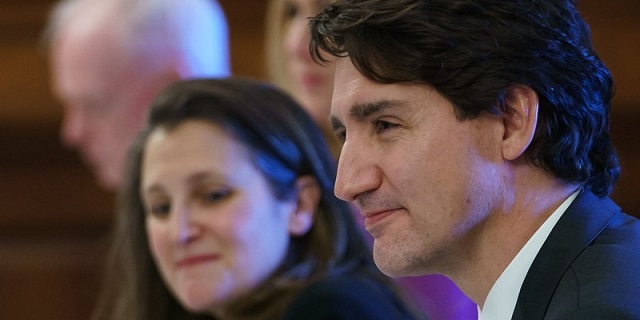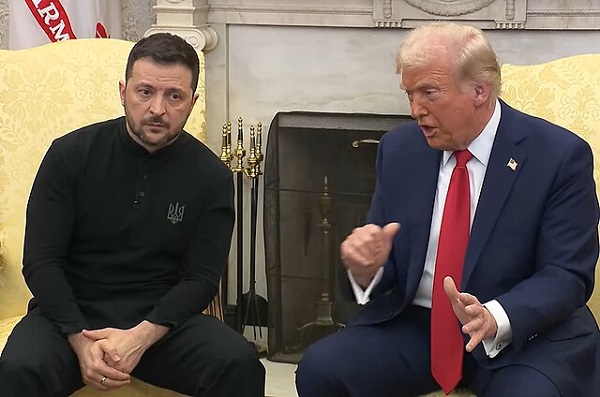Economy
400,000 more Canadians live in poverty now compared to 2020: gov’t report

From LifeSiteNews
A report by the federal government has found that ‘9.9 percent of Canadians, some four million people, live in poverty compared to 6.4 percent in 2020, the equivalent of approximately 400,000 more Canadians.’
Decades of progress in lowering the poverty rate in Canada has been wiped out in the last few years under Prime Minister Justin Trudeau’s Liberal government, one of his own federal departments has reported.
According to Blacklock’s Reporter, a recently released report dated December 11, 2023 by the Department of Social Development “estimates” that “9.9 percent of Canadians, some four million people, live in poverty compared to 6.4 percent in 2020, the equivalent of ‘approximately 400,000 more Canadians,’” and that “[f]uture increases in the rate of poverty could stall progress towards reaching the 2030 poverty reduction target of a 50 percent reduction in poverty versus 2015 levels.”
The report observed that high inflation in Canada combined with “lagging household incomes” has led to “affordability pressures among many households.”
While the uptick in the poverty rate is certainly concerning for many Canadians, it may come as little surprise as this is not the first time one of Trudeau’s own departments has warned of such a trend.
In January, the National Advisory Council on Poverty (NACP) observed to Parliament that fast-rising food costs have led to many people feeling a sense of “hopelessness and desperation.”
“Persons with lived expertise of poverty and service providers alike told us things seem worse now than they were before and during the first years of the pandemic,” read the NACP report.
“We heard that people are worried about the rising cost of living and inflation,” it continued, adding, “More people are in crisis and these crises are more visible in our communities.”
The damning figures comes as critics, including the nation’s leading taxpayer watchdog, the Canadian Taxpayers Federation, have warned that the Trudeau government’s deficit spending and oft-increasing tax regime has been putting undue strain on the pocketbooks of its citizens.
Previously speaking to LifeSiteNews, CTF federal director Franco Terrazzano urged the Trudeau government to cut spending, balance the budget and “completely scrap” the “carbon tax.”
“More debt means more money wasted on interest charges and less room to cut taxes,” Terrazzano stated, warning that “[i]n a handful of years, every penny collected from the GST (Goods and Service Tax) will go toward paying interest on the debt.”
Under Trudeau, Canadians have seen their overall tax rate go up thanks to the punitive carbon tax that affects all goods and services in the nation.
Even the Bank of Canada, the nation’s central bank, has taken issue with Trudeau government policy, acknowledging last year that some of its federal “climate change” programs, which have been deemed “extreme” by provincial leaders, are helping to fuel inflation.
Business
It Took Trump To Get Canada Serious About Free Trade With Itself

From the Frontier Centre for Public Policy
By Lee Harding
Trump’s protectionism has jolted Canada into finally beginning to tear down interprovincial trade barriers
The threat of Donald Trump’s tariffs and the potential collapse of North American free trade have prompted Canada to look inward. With international trade under pressure, the country is—at last—taking meaningful steps to improve trade within its borders.
Canada’s Constitution gives provinces control over many key economic levers. While Ottawa manages international trade, the provinces regulate licensing, certification and procurement rules. These fragmented regulations have long acted as internal trade barriers, forcing companies and professionals to navigate duplicate approval processes when operating across provincial lines.
These restrictions increase costs, delay projects and limit job opportunities for businesses and workers. For consumers, they mean higher prices and fewer choices. Economists estimate that these barriers hold back up to $200 billion of Canada’s economy annually, roughly eight per cent of the country’s GDP.
Ironically, it wasn’t until after Canada signed the North American Free Trade Agreement that it began to address domestic trade restrictions. In 1994, the first ministers signed the Agreement on Internal Trade (AIT), committing to equal treatment of bidders on provincial and municipal contracts. Subsequent regional agreements, such as Alberta and British Columbia’s Trade, Investment and Labour Mobility Agreement in 2007, and the New West Partnership that followed, expanded cooperation to include broader credential recognition and enforceable dispute resolution.
In 2017, the Canadian Free Trade Agreement (CFTA) replaced the AIT to streamline trade among provinces and territories. While more ambitious in scope, the CFTA’s effectiveness has been limited by a patchwork of exemptions and slow implementation.
Now, however, Trump’s protectionism has reignited momentum to fix the problem. In recent months, provincial and territorial labour market ministers met with their federal counterpart to strengthen the CFTA. Their goal: to remove longstanding barriers and unlock the full potential of Canada’s internal market.
According to a March 5 CFTA press release, five governments have agreed to eliminate 40 exemptions they previously claimed for themselves. A June 1 deadline has been set to produce an action plan for nationwide mutual recognition of professional credentials. Ministers are also working on the mutual recognition of consumer goods, excluding food, so that if a product is approved for sale in one province, it can be sold anywhere in Canada without added red tape.
Ontario Premier Doug Ford has signalled that his province won’t wait for consensus. Ontario is dropping all its CFTA exemptions, allowing medical professionals to begin practising while awaiting registration with provincial regulators.
Ontario has partnered with Nova Scotia and New Brunswick to implement mutual recognition of goods, services and registered workers. These provinces have also enabled direct-to-consumer alcohol sales, letting individuals purchase alcohol directly from producers for personal consumption.
A joint CFTA statement says other provinces intend to follow suit, except Prince Edward Island and Newfoundland and Labrador.
These developments are long overdue. Confederation happened more than 150 years ago, and prohibition ended more than a century ago, yet Canadians still face barriers when trying to buy a bottle of wine from another province or find work across a provincial line.
Perhaps now, Canada will finally become the economic union it was always meant to be. Few would thank Donald Trump, but without his tariffs, this renewed urgency to break down internal trade barriers might never have emerged.
Lee Harding is a research fellow with the Frontier Centre for Public Policy.
Alberta
Low oil prices could have big consequences for Alberta’s finances

From the Fraser Institute
By Tegan Hill
Amid the tariff war, the price of West Texas Intermediate oil—a common benchmark—recently dropped below US$60 per barrel. Given every $1 drop in oil prices is an estimated $750 million hit to provincial revenues, if oil prices remain low for long, there could be big implications for Alberta’s budget.
The Smith government already projects a $5.2 billion budget deficit in 2025/26 with continued deficits over the following two years. This year’s deficit is based on oil prices averaging US$68.00 per barrel. While the budget does include a $4 billion “contingency” for unforeseen events, given the economic and fiscal impact of Trump’s tariffs, it could quickly be eaten up.
Budget deficits come with costs for Albertans, who will already pay a projected $600 each in provincial government debt interest in 2025/26. That’s money that could have gone towards health care and education, or even tax relief.
Unfortunately, this is all part of the resource revenue rollercoaster that’s are all too familiar to Albertans.
Resource revenue (including oil and gas royalties) is inherently volatile. In the last 10 years alone, it has been as high as $25.2 billion in 2022/23 and as low as $2.8 billion in 2015/16. The provincial government typically enjoys budget surpluses—and increases government spending—when oil prices and resource revenue is relatively high, but is thrown into deficits when resource revenues inevitably fall.
Fortunately, the Smith government can mitigate this volatility.
The key is limiting the level of resource revenue included in the budget to a set stable amount. Any resource revenue above that stable amount is automatically saved in a rainy-day fund to be withdrawn to maintain that stable amount in the budget during years of relatively low resource revenue. The logic is simple: save during the good times so you can weather the storm during bad times.
Indeed, if the Smith government had created a rainy-day account in 2023, for example, it could have already built up a sizeable fund to help stabilize the budget when resource revenue declines. While the Smith government has deposited some money in the Heritage Fund in recent years, it has not created a dedicated rainy-day account or introduced a similar mechanism to help stabilize provincial finances.
Limiting the amount of resource revenue in the budget, particularly during times of relatively high resource revenue, also tempers demand for higher spending, which is only fiscally sustainable with permanently high resource revenues. In other words, if the government creates a rainy-day account, spending would become more closely align with stable ongoing levels of revenue.
And it’s not too late. To end the boom-bust cycle and finally help stabilize provincial finances, the Smith government should create a rainy-day account.
-

 2025 Federal Election1 day ago
2025 Federal Election1 day agoPoilievre Campaigning To Build A Canadian Economic Fortress
-

 Automotive1 day ago
Automotive1 day agoCanadians’ Interest in Buying an EV Falls for Third Year in a Row
-

 conflict2 days ago
conflict2 days agoTrump tells Zelensky: Accept peace or risk ‘losing the whole country’
-

 2025 Federal Election1 day ago
2025 Federal Election1 day agoAs PM Poilievre would cancel summer holidays for MP’s so Ottawa can finally get back to work
-

 armed forces18 hours ago
armed forces18 hours agoYet another struggling soldier says Veteran Affairs Canada offered him euthanasia
-

 conflict18 hours ago
conflict18 hours agoWhy are the globalists so opposed to Trump’s efforts to make peace in Ukraine?
-

 Alberta8 hours ago
Alberta8 hours agoGovernments in Alberta should spur homebuilding amid population explosion
-

 Entertainment2 days ago
Entertainment2 days agoPedro Pascal launches attack on J.K. Rowling over biological sex views






